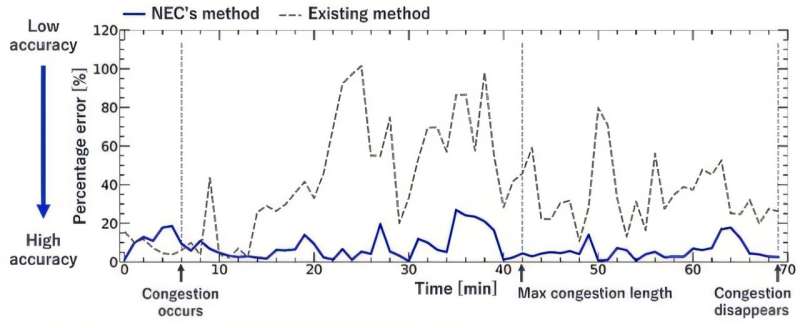NEC Corporation has developed an optical fiber sensing technology to monitor road conditions and accurately predict sudden traffic congestion in real time. By collecting data from existing optical fiber communications cables and analyzing real-time traffic flow data using a proprietary AI model, the researchers have reduced prediction errors by 80% compared to conventional methods.
This technology enables effective traffic control, including the arrangement of detour routes, thereby contributing to the resolution of societal challenges such as logistics issues and CO2 emissions.
Technology overview
Traffic congestion is a significant social issue, threatening safety and causing substantial economic losses. In particular, congestion on expressways—the backbone of many logistics networks—has a significant economic impact. Addressing this issue requires real-time understanding of road conditions for both immediate congestion mitigation and proactive avoidance, as well as highly accurate congestion prediction based on up-to-date data.
Current monitoring approaches primarily rely on point-based instruments, including cameras and loop detectors, as well as probe vehicle data. However, both have limitations: the former is costly to install and maintain over entire road networks, and the latter only provides data when equipped vehicles pass by specific receiver points, limiting real-time and continuous coverage. Moreover, existing congestion prediction models heavily rely on long-term historical data, making it difficult to capture the emergence and propagation of sudden, unexpected congestion patterns.
To address these challenges, NEC has developed a technology that utilizes optical fiber cables—originally installed for communications purposes alongside roads—as extensive, distributed sensors for collecting real-time, continuous traffic flow data across entire routes. NEC’s unique AI-powered model then provides real-time, high-precision predictions regarding the development and clearance of sudden congestion.

Technical features
NEC has developed a data assimilation algorithm that combines advanced model parameter optimization and data adapting techniques, enabling accurate simulations of real-time traffic flow using comprehensive data collected along the entirety of roadways.
The team has created an algorithm to optimize theoretical model parameters—such as driver behaviors (e.g., inter-vehicle distance adjustment)—so that simulations faithfully reproduce observed traffic flow data for entire road segments.
Data adaptation algorithm
An advanced algorithm converts diverse traffic flow data, including “average speed” and individual vehicle “position/speed,” into formats compatible with simulation inputs. This makes it possible to set the initial conditions for simulations based on comprehensive traffic flow data obtained on entire routes, significantly enhancing the reliability of simulation outputs.
Through these innovations, the researchers have confirmed—using real-world data—that travel time prediction errors (a key indicator for congestion forecasting) can be reduced by approximately 80% compared to the existing method that relies on cross-sectional data from point sensors such as cameras.
NEC is further advancing the realization of a dynamic road digital twin that enables real-time, network-wide traffic monitoring, the prediction of congestion evolution, and optimization of responsive measures. Real-world trials are currently underway in close collaboration with road authorities, with the goal of practical deployment by fiscal 2026.
This technology was developed using data provided by Central Nippon Expressway Company Limited (NEXCO CENTRAL) and was presented at the Transportation Research Board 104th Annual Meeting held in Washington D.C. January 5–9, 2025 as a paper titled “A Novel Approach to Real-Time Short-Term Traffic Prediction based on Distributed Fiber-Optic Sensing and Data Assimilation with a Stochastic Cell-Automata Model.” It is available on the arXiv preprint server.
A related paper will be presented at the 31st ITS World Congress in Atlanta, Georgia, U.S. held August 24–28, focused on enhancing the accuracy of traffic flow monitoring on expressways.
More information:
Yoshiyuki Yajima et al, A Novel Approach to Real-Time Short-Term Traffic Prediction based on Distributed Fiber-Optic Sensing and Data Assimilation with a Stochastic Cell-Automata Model, arXiv (2025). DOI: 10.48550/arxiv.2501.03628
Provided by
NEC
Citation:
Predicting sudden traffic congestion in real time using optical fiber cables (2025, August 25)
retrieved 26 August 2025
from https://techxplore.com/news/2025-08-sudden-traffic-congestion-real-optical.html
This document is subject to copyright. Apart from any fair dealing for the purpose of private study or research, no
part may be reproduced without the written permission. The content is provided for information purposes only.

